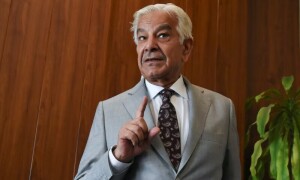• Planning body okays proposal worth Rs211bn
• Shoro says CCI yet to decide on Sindh’s complaint over the plan
HYDERABAD: The Sindh government has expressed serious concerns over the approval of a new irrigation project worth over Rs200 billion in Punjab.
The two provinces have repeatedly come face-to-face over water sharing, with Sindh being a lower riparian province accusing Punjab of not allowing adequate water flow downstream.
Now, the row over is set to escalate as the Central Development Working Party (CDWP) has approved an entirely new irrigation system for Punjab.
The province plans to build a 176km-long Cholistan canal and a 120km-long Marot canal in the Cholistan area.
The Sindh government has already submitted a complaint over this project to the Council of Common Interests (CCI), on which a decision is still awaited.
In a summary sent to the CCI in July, the Sindh government protested against the Water Availability Certificate (WAC) issued to the project by the water regulator, Indus River System Authority in January.
It questioned before CCI the two new canals — Jalalpur canal being built on the right side of Rasul Barrage and Cholistan on its left side — and claimed the water regulator had “overstepped its authority” by issuing the certificate.
Sindh Irrigation Minister Jam Khan Shoro has questioned CDWP’s approval as the Executive Committee of the National Economic Council — which approves major developmental projects in provinces — linked the move with CCI’s decision on Sindh’s complainant.
He was referring to Ecnec’s observation on Feb 7, where it stated that the summary submitted by the planning ministry for the “Development of National Irrigation Network for Green Pakistan Initiative” will be “subject to approval by CCI”.
He added that as per the working paper of Saturday’s CDWP meeting, the project, costing Rs211.34bn, will be completed by July 2030.
According to the cost breakdown in the working paper seen by Dawn, Rs 174bn will be spent on construction: Rs76.57bn for the Cholistan Canal, Rs47.6bn for Marot Canal, Rs39.19bn for link canals, Rs 800m for mechanical work and Rs10bn to account for escalation in construction cost.
The remaining amount will be spent on other aspects like afforestation, land acquisition, project management, etc.
Water availability
According to Mr Shoro, a pre-CDWP meeting held on Sept 2 was told that the capacity of three link canals — Rasul-Qadirabad, Qadirabad-Balloki and Balloki-Sulemanki — would be enhanced to 25,000, 25,000 cusecs and 28,700 cusecs, respectively, to draw water for this project.
“We don’t know the existing capacity of these canals,” he remarked.
The minutes of the Sept 2 meeting said the Cholistan canal was originally conceived to be a non-perennial canal, which doesn’t flow throughout the year.
However, given the needs of this region and the possibility of flow adjustments among various canals in Punjab, the minutes stated, the canal is now planned to be executed as a perennial canal.
In periods where there is no flood, the water for the canal would be diverted from other water bodies and through “departmental adjustments”. Mr Shoro said the term departmental adjustments had not been explained to date.
While referring to the figures — quoted by Punjab — of water flow downstream Kotri, he said the difference between 17.29MAF in the pre-climate change era — in August from 1976 to 1998 — and 6.921MAF — in August from 1999 and 2023 — offers a different picture of Kotri downstream flows pattern.
Punjab has defended the water availability certificate (issued by Irsa in Jan 2024) of 0.449MAF out of flood share in favour of “smaller Cholistan” has been granted from the province’s flood share under para-4 of the Water Apportionment Act 1991.
In its submission to the planning ministry, Punjab claimed that the storage capacity of Bhasha and Mohmand dams would enable it to receive increased flows, which would “enhance existing irrigation systems and ensure sufficient water supply for new projects”.
However, the planning ministry, in its document, stated that the Punjab government has not provided data for water availability from the two reservoirs.
According to Mr Shoro, the document also said the panel of experts appointed by the Centre put the environmental flow of the river (EFR) below Kotri at 8.6 MAF. The data of average flows from 1976 to 2022 create a “mirage” as many years have witnessed meagre EFR and the number of “no flow days” have increased, Mr Shoro said, while quoting the document.
Published in Dawn, October 14th, 2024













































